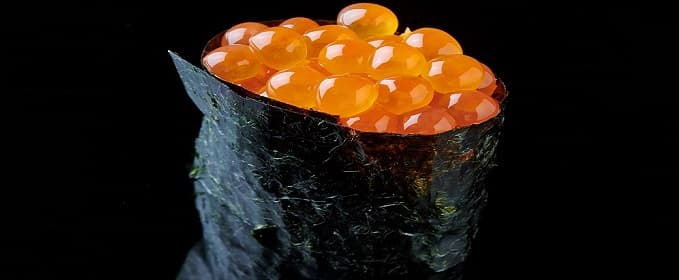History, meaning and kinds of salmon roe (ikura)
Ikura and Sujiko are little different!?
Salmon roe also called red caviar is very popular among Japanese of all ages. It is sold in most grocery stores, and sushi or it on top of a rice bowl is very popular. Salmon roe is called Ikura in Japanese from around 1910. The origin of Ikura is Russian language "икра". However, Japanese eat a salmon roe as Sujiko from 1697 according to the Honcho-shokkan written by Hitsudai Hitomi.
Sujiko is salmon roes covered with a film of ovary. Ikura is scattered salmon roes. In addition, Sujiko is smaller and softer than Ikura because it is more immature. It preserved with salt was popular in the past, but with soy sauce is popular now. Homemade Sujiko is more popular in Hokkaido prefecture than ready-to-eat of it. Homemade Ikura made from grown Sujiko is also popular there. Ikura and Sujiko are different in Japan though both of them are salmon roes.

Name of Ikura began to take root from 1910s. The fishery of salmon was developing, Maruha Nichiro Co. which is one of the large seafood companies in Japan built a factory for salmon in Russia. Some seafood companies including Maruha Nichiro imported salmon and salmon roe. Russian people called salmon roe Ikura then, these companies imported salmon roe as Ikura. Ikura was spreading all over Japan through that. Japanese not only in Hokkaido prefecture but also in other area ate it from then on.
Ikura was eaten by Japanese from 1910s, but it was regarded as delicacy for a long time. Ginza Kyubey is well known as the first sushi restaurant for serving Ikura sushi from 1941. Hisaji Imada who was the founder of this sushi restaurant made it for regular customer. He thought Gunkan-maki (Battleship sushi) not to spill Ikura from rice. This sushi with Ikura became popular soon, and sushi with sea urchin also became popular.

Ginza Kyubey does not serve Gunkan-maki with a slice of cucumber, but some sushi restaurants serve it with a cucumber. The reason of that is not only adding texture but also soy sauce. These restaurants serve a slice of cucumber for applying it on soy sauce. If Gunkan-maki dip on soy sauce directly, a topping of it spills from rice. Some sushi restaurants including Kyubey serve slices of ginger called Gari for applying sushi on soy sauce.
By the way, there is Ikura made from trout roe in Japan. This Ikura is called Masu-Ikura to distinguish it from Ikura made from salmon roe. Masu-Ikura is smaller than Ikura though its shape is looks like Ikura. The price of it is about 30% cheaper than the price of Ikura. In addition, it tastes lighter than Ikura.
There are various Ikura dishes in Japan, Ikura-don (rice bowl topped with Ikura), Sake-Ikura-don (rice bowl topped with Ikura and salmon meat) and more. Nowadays, it is used as ingredients of pasta, pizza, carpaccio and canape. If you hesitate to eat raw seafood, it might to be a good to eat Ikura for the first step. Ikura is always in top 5 of the favorite sushi ranking for children though many children do not like raw fish very much. Other sushi, egg, Natto (fermented soybeans), salmon and shrimp are also in top 5 of the ranking.


The best season of Ikura is October or November in Hokkaido prefecture. However, it can be eaten throughout the year by freezing technology and importing from Russia. If you like sushi and conveyor belt sushi restaurant, you can invest it. Food and life companies (TYO:3563) and Kura Sushi Inc (TYO:2695) are listed in Tokyo Stock Exchange. If you like Ikura dishes, you can invest Maruha Nichiro Co. (TYO:1333) which is the one of the largest Japanese seafood companies in Japan. These companies are also included some ETFs for investing Japanese companies.
- Ikura and Sujiko are little different!?
- Shake means salmon, but they are different!?
- Various crab and crab dishes in Japan!?
- What is Kappa-maki and Kappa?
- Good-old sushi restaurants do not serve raw shrimp sushi!?
- Japanese eat various squid and squid dishes!?
- There are various toro, that is confusing!?
- Various tuna and tuna dishes in Japan!?
- There are various way to use wasabi!?

 Gyudon
Gyudon Katsudon
Katsudon Unadon
Unadon Kaisendon
Kaisendon